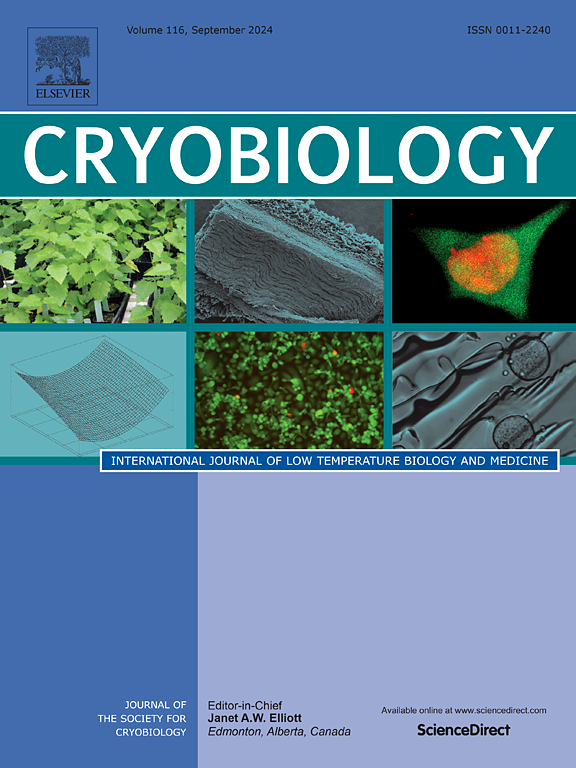Comparison of the effect of adding different levels of selenium nanoparticles doped with zinc oxide nanoparticles, and selenium nanoparticles doped with zinc oxide nanoparticles coated with Resveratrol on post-thawing quality of ram semen
IF 2.1
3区 生物学
Q2 BIOLOGY
引用次数: 0
Abstract
Reactive oxygen species (ROS) can potentially cause harm to sperm following cryopreservation. The primary defense against this oxidative damage is antioxidants. One powerful antioxidant is resveratrol (Res), a stilbenoid that belongs to the family of natural phenols and polyphenols. Res is found in various foods, including mulberries, blueberries, raspberries, and grape skins. Antioxidants are essential for protecting sperm because free radicals negatively impact oxidative stress processes. However, the effectiveness of Res is limited due to its poor bioavailability. To address this limitation, loading strategies that utilize nanoparticles and nanotechnology can be employed. In this study, barberry extract was used to create selenium nanoparticles doped with zinc oxide nanoparticles (NSe-do-NZn), which were then coated with Res (NSe-do-NZn-co-Res). Energy-dispersive X-ray spectroscopy (EDX), UV–visible spectroscopy, field emission scanning electron microscopy (FE-SEM), zeta potential analysis, and Fourier-transform infrared spectroscopy (FTIR) were among the tests used to validate the production of nanoparticles. This study aims to investigate the effects of Res-coated NSe-do-NZn on ram sperm parameters after the thawing. Following thawing, various sperm parameters were assessed, including malondialdehyde (MDA) concentration, total motility, viability, plasma membrane, DNA integrity, and abnormalities. The results showed that the addition of 5 μg/ml of NSe-do-NZn-co-Res significantly enhanced sperm survival and total motility during thawing compared to other groups (P < 0.05). Furthermore, this treatment notably improved the percentage of DNA integrity and cell membrane functionality compared to other groups, except for the group receiving 5 μg/ml NSe-do-NZn and the 25 μg/ml Res group (P < 0.05). Similar trends were observed for the reduction in MDA levels and sperm abnormalities. The most significant outcomes were associated with the use of resveratrol coated onto NSe-do-NZn.
比较添加不同水平的硒纳米粒子掺杂氧化锌纳米粒子和硒纳米粒子掺杂白藜芦醇包被氧化锌纳米粒子对公羊精液解冻后质量的影响
活性氧(ROS)可能对冷冻后的精子造成潜在的伤害。抗氧化损伤的主要防御是抗氧化剂。一种强大的抗氧化剂是白藜芦醇(Res),它是一种天然酚类和多酚类化合物。Res存在于多种食物中,包括桑葚、蓝莓、覆盆子和葡萄皮。抗氧化剂对保护精子至关重要,因为自由基会对氧化应激过程产生负面影响。然而,由于其生物利用度差,其有效性受到限制。为了解决这一限制,可以采用利用纳米粒子和纳米技术的加载策略。在本研究中,利用巴贝提取物制备了掺杂氧化锌纳米粒子(NSe-do-NZn)的硒纳米粒子,然后在其表面涂覆Res (NSe-do-NZn-co-Res)。能量色散x射线光谱(EDX)、紫外可见光谱、场发射扫描电子显微镜(FE-SEM)、ζ电位分析和傅里叶变换红外光谱(FTIR)都是用于验证纳米颗粒生产的测试之一。本研究旨在探讨res包被NSe-do-NZn对解冻后公羊精子参数的影响。解冻后,评估各种精子参数,包括丙二醛(MDA)浓度、总运动性、活力、质膜、DNA完整性和异常。结果表明,与其他各组相比,添加5 μg/ml NSe-do-NZn-co-Res显著提高了解冻过程中精子存活率和总活力(P < 0.05)。此外,除5 μg/ml NSe-do-NZn组和25 μg/ml Res组外,与其他组相比,该处理显著提高了DNA完整性百分比和细胞膜功能(P < 0.05)。在MDA水平降低和精子异常方面也观察到类似的趋势。最显著的结果与使用白藜芦醇涂覆在NSe-do-NZn上有关。
本文章由计算机程序翻译,如有差异,请以英文原文为准。
求助全文
约1分钟内获得全文
求助全文
来源期刊

Cryobiology
生物-生理学
CiteScore
5.40
自引率
7.40%
发文量
71
审稿时长
56 days
期刊介绍:
Cryobiology: International Journal of Low Temperature Biology and Medicine publishes research articles on all aspects of low temperature biology and medicine.
Research Areas include:
• Cryoprotective additives and their pharmacological actions
• Cryosurgery
• Freeze-drying
• Freezing
• Frost hardiness in plants
• Hibernation
• Hypothermia
• Medical applications of reduced temperature
• Perfusion of organs
• All pertinent methodologies
Cryobiology is the official journal of the Society for Cryobiology.
 求助内容:
求助内容: 应助结果提醒方式:
应助结果提醒方式:


